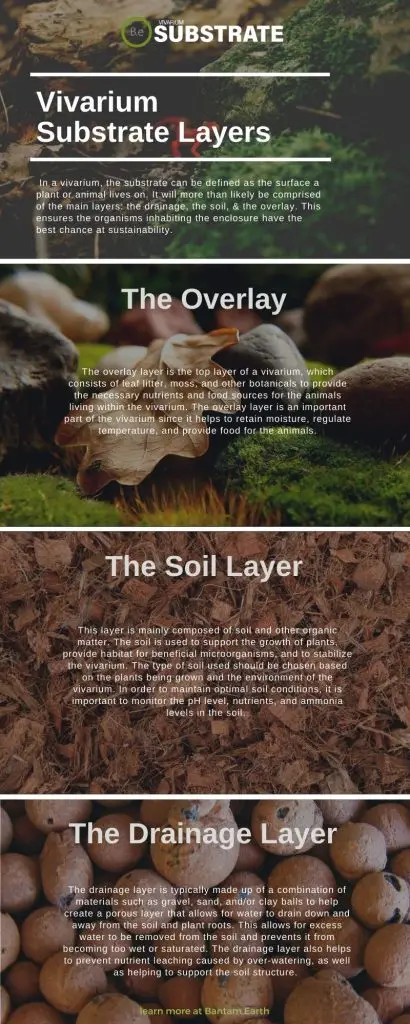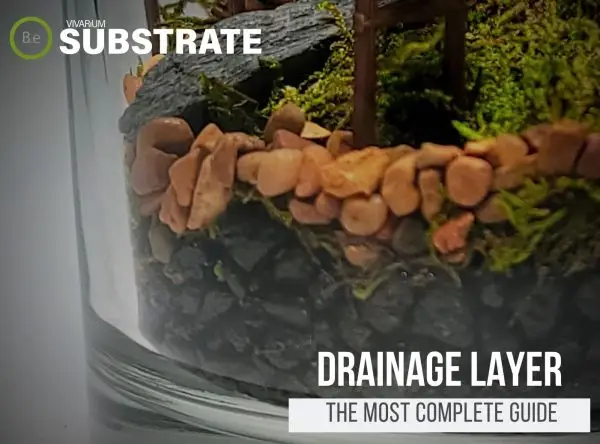

Vivarium Substrates
Substrates are essentially the lifeline of an enclosure. Every biotype should consist of some kind of substrate material. In a vivarium, the substrate can be defined as the surface a plant or animal lives on.
Typically, a hobbyist will think of only soil when the subject of the substrate is brought up. In many cases, hardscapes and even other plants can act as living surfaces for organisms and not just various soils.
When designing a vivarium from scratch, choosing a suitable substrate would usually be the next step after deciding on the hardscape material. Once you’ve settled on the types of rocks or woods that will make up the hardscape structure of the enclosure, it’s time to consider the substrate and its layout.
Bioactive vivariums that will consist of a soil-based substrate, will more than likely be comprised of three main layers: a drainage layer, a soil layer, and an overlay of botanicals.
This ensures the organisms inhabiting the enclosure have the best chance at sustainability. Not all enclosures are created equal. In addition, your individual tank may or may not require all of these layers. Aquariums for instance don’t require drainage layers.
This guide will give a general understanding of using substrates in bioactive terrariums. For a more detailed guide on a specific type of vivarium, check out these articles for a better reference.


The Drainage Layer
The drainage layer is a foundational layer of a terrarium’s substrate. This area will consist of elements that store access water and redistribute it back into the soil in the form of humidity. Beneficial bacteria as well as organisms that break down harmful toxins will accumulate here.
The subdivision of this layer can be broken down into two parts: A drainage section and a separator. Separating the drainage layer from the soil will allow the elements in the second layer from becoming oversaturated. Preventing the soil from coming into direct contact with standing water.
The screen separator also plays a vital role in blocking roots and inhabitants from burrowing into this bottom area. The depth of the drainage layer will depend entirely on the overall size of the vivarium.
The overall layer is often referred to as a false bottom and it will either consist of some time of substrate material or remain completely open to allow more room for water. Both types of drainage methods will have their pros and cons. It mostly comes down to preference.
The Soil Layer
The soil layer is the part of the substrate from which most plants will consume their nutrients. Many inhabitants as well as beneficial bacteria will even find this area home. Essentially, this region will be comprised of mostly soil of some kind.
Soil by definition is the combination of broken-down rocks and organic material. The organic material will consist of decomposing plants and animals. Depending on the biotype being set up, the ideal soil in this layer of the substrate will vary.
Choosing the right type of soil combination is imperative to a thriving ecosystem. Many hobbyists make the mistake of not understanding this part of the build only to have problems later down the line.
Once you know what type of substrate combination is right for your enclosure’s biotype, setting up this layer correctly early on will lead to a higher success rate with plants And animals.
Check out the tailored guides below for more info on how to correctly mix soil for a particular biotype.
The Overlay Layer
The overlay layer is made up of decomposable elements that aid in water retention. This can include leaf litter, moss, and/or other various types of ground cover. Not all biotypes will consist of an overlay. Those that do require ground cover will find a multitude of benefits with utilizing this layer.
Ground cover can provide additional hiding spots for non-borrowing animals to find refuge under. As this layer begins to decompose, valuable nutrients will leach down into the soil layer supplying roots and microfauna with a consistent amount of additional nourishment.
Moss can act as both a natural way to retain moisture in the soil as well as act as a buffer to keep PH levels at a necessary low. In addition, the overlay layer can also offer a very natural touch of realism to the vivarium as many areas in nature have fallen debris.


If you are contemplating on what types of ground cover you should use for your setup… Here are some helpful guides on individual overlays you can look further into. A combination of these materials could be used together or separately depending on preference.
Browse Substrate Guides
- All
- Additives
- Compost
- Drainage
- Leaf Litter
- Soil


Activated Charcoal (Active Carbon)


Akadama (Volcanic Clay)


Aspen Bedding (Wood Fiber)


Coconut Coir (Peat, Fiber, & Chip)


Cypress Bark (Cypress Mulch)


Douglas Fir Bark (Forest Bark)


Earthworm Castings (Vermicompost)


Expanded Clay Pebbles (Hydroton, LECA)


Horticultural Charcoal (Inactive Carbon)


Magnolia Leaves (Magnolia Grandiflora)


Perlite Soil (Puffed Volcanic Glass)


Pine Bark Mulch (Reptile Mulch)


Pumice Soil (Floating Pebble)


Tree Fern Fiber (Fern Wood)


Turface (Calcined Clay)






